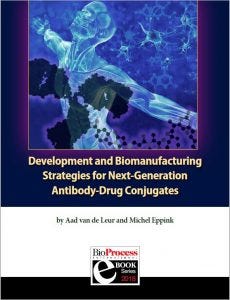Voices of Biotech
Podcast: MilliporeSigma says education vital to creating unbreakable chain for sustainability
MilliporeSigma discusses the importance of people, education, and the benefits of embracing discomfort to bolster sustainability efforts.
 The development and manufacture of antibody-drug conjugates (ADCs) requires a series of complex steps. ADC manufacturers must comply with guidelines for both the small-molecule linker-drug and the monoclonal antibody (MAb). The authors describe their company’s development of its lead ADC product. They review process decisions, including the issues that factored into their selection of single-use systems, manufacturing challenges (differences between ADCs and MAbs), and testing methodologies for extractables and leachables.
The development and manufacture of antibody-drug conjugates (ADCs) requires a series of complex steps. ADC manufacturers must comply with guidelines for both the small-molecule linker-drug and the monoclonal antibody (MAb). The authors describe their company’s development of its lead ADC product. They review process decisions, including the issues that factored into their selection of single-use systems, manufacturing challenges (differences between ADCs and MAbs), and testing methodologies for extractables and leachables.
Synthon began as a small-molecule generics company in 1991. During that time, the generics market had just begun to separate from the rest of the pharmaceutical market. The company grew in this area, and in 2007 when fewer products were coming off patent, Synthon expanded its portfolio into biosimilars. It developed its first biosimilar from trastuzumab (Herceptin), which was then outlicensed to Amgen/Actavis and today is an EMA-approved product marketed in Europe. As the market continued to change, Synthon didn’t continue to develop its biosimilars franchise and focused instead on new
therapies in its newly set-up daughter company Synthon Biopharmaceuticals.. In 2011 the company acquired Syntarga, a small company in Nijmegen, The Netherlands, which had developed the technology to couple its proprietary linker-drug to antibodies. From then onward, Synthon Biopharmaceuticals focused on antibody-drug conjugates (ADCs), naked antibodies (e.g., immuno-oncology products), and some small-molecule products. Today, Synthon’s innovative pipeline includes four ADCs and several other new molecular entities in different stages of development in addition to its rich portfolio of generic products on the market.
The company’s lead compound, ADC SYD985 (trastuzumab duocarmazine) has been granted “fast-track” designation by the US Food and Drug Administration (FDA) and as of late last year has been in a pivotal phase 3 study. Here, we describe our studies in clinical manufacturing of SYD985, including what factored into our decision to implement single-use systems and our methodology for testing potential extractables and leachables.
Just fill out the form below to download the eBook now.
You May Also Like